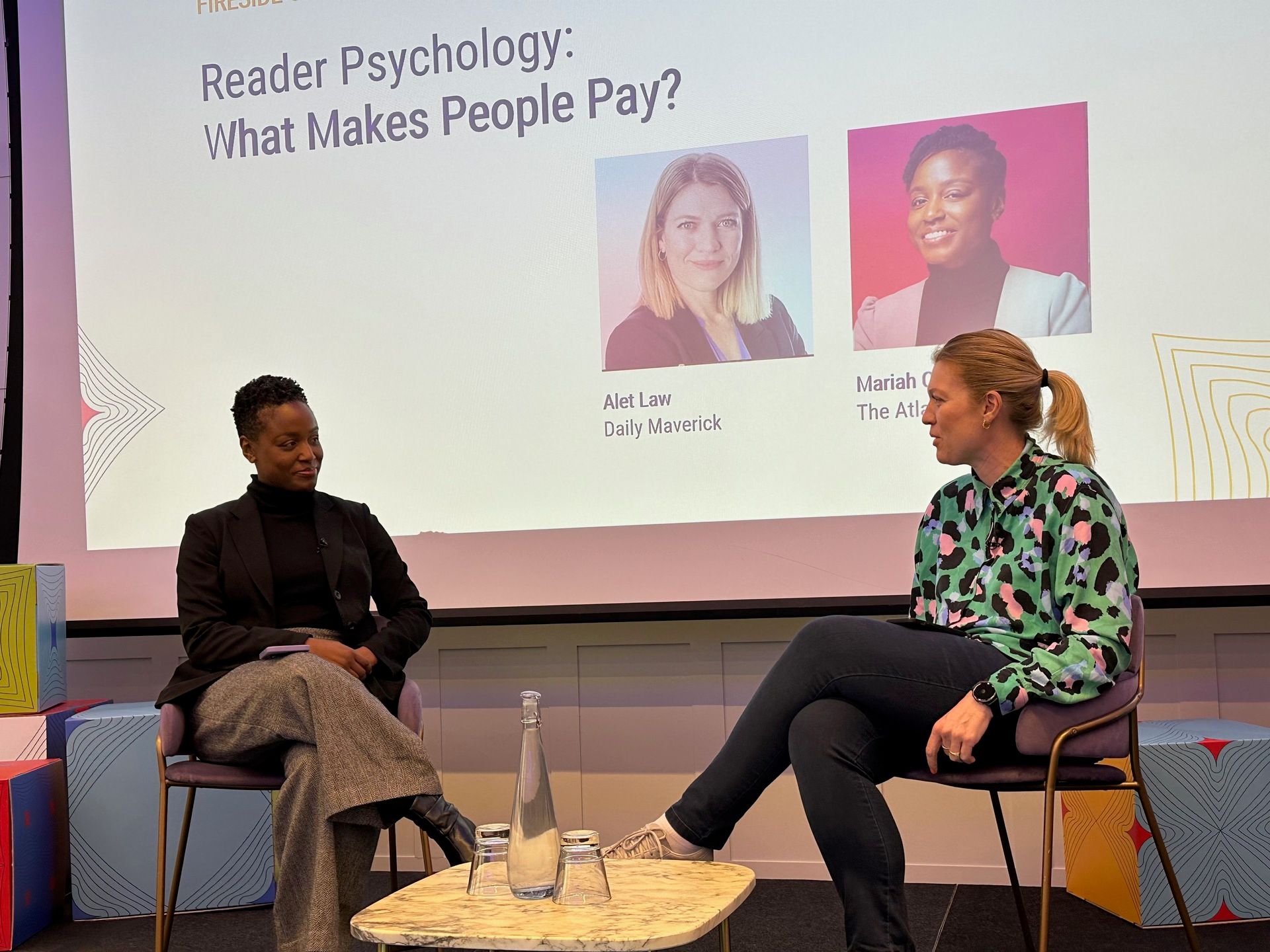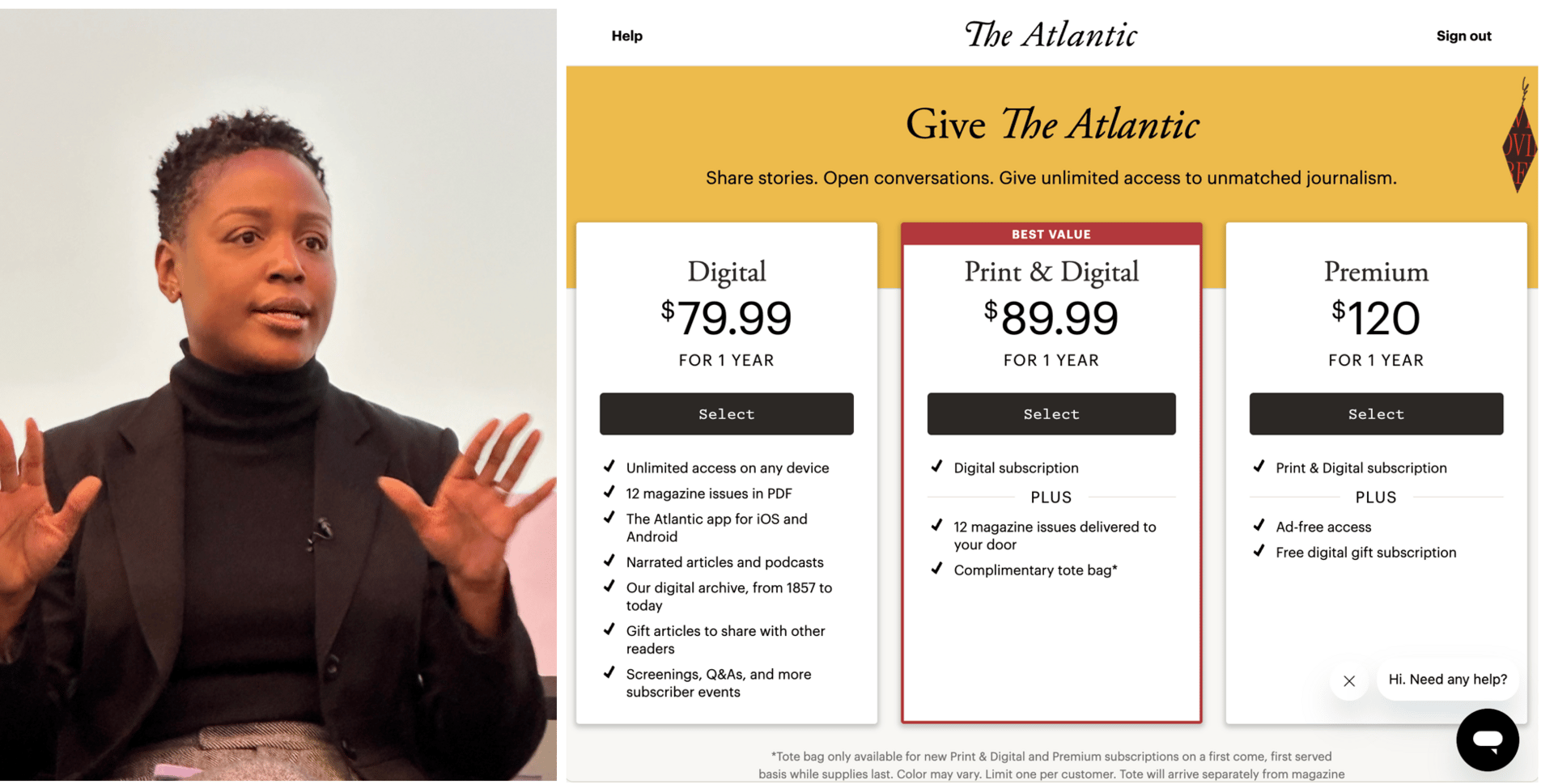
Mariah Craddick, Executive Director of Product at The Atlantic (left), in a fireside chat at the Journalism AI Festival last week
A note to my subscribers:
News Machines is a free newsletter, only supported by ads. I don’t make any money with it, and it costs me money to host it on Beehiiv. If you value my weekly case studies and want to keep this newsletter free, please don’t ignore the ads (I get paid per click). There is only one selected ad per newsletter. Thank you!
When Mariah Craddick's data scientist kept repeating the same finding, it contradicted everything the industry assumed about smart paywalls. "She said, if you put the gate up, it's always gonna win," Craddick told me in a recent conversation. After years of testing sophisticated metering rules, The Atlantic arrived at a surprisingly simple conclusion: the hard paywall outperformed every clever variation they had ever tried.
Craddick is Executive Director of Product at The Atlantic, where she's led product strategy for four years. She oversees the product and strategy team for monetization and growth. Her path mirrors the discipline's evolution: she started as a journalist, moved into audience development, pitched an audience engagement editor role at Crain Communications, then progressed through McClatchy and the Wall Street Journal before joining The Atlantic. Today, her role has expanded to include working with the business development team on syndication and LLM strategy. I talked to her last week during the Journalism AI Festival in London where she was in a fireside chat and I co-hosted a Gen AI quiz show.
Paywall experiments failed to impress
The Atlantic launched its paywall in 2019 with some free page view limit. "And then over time, we started to tighten it, tighten it, tighten it," Craddick explained in our conversation. The team tested extensively between 2019 and 2022, a period marked by significant news events that moved metrics in unpredictable ways.
They experimented with dynamic metering that could assess advertising value versus subscription value and decide in real-time what to show each user. The implementation was manual at first and tested through A/B/C/D variations. Users from certain referrers might see the paywall on the second article instead of the first, with different messaging depending on behavior patterns.
The result? "We were eking out inconsequential lift from these experiments," Craddick said. The sophisticated personalization simply didn't move the needle in meaningful ways. What did work was straightforward: putting the paywall up earlier in the user journey. Every test confirmed this. The hard gate won consistently.
But Craddick is clear about the critical precondition: "The thing behind it has to be valuable. And I think it just signifies to people, this is something I have to pay for." A hard paywall only functions as intended when the journalism justifies the barrier. Otherwise, it simply drives people away.
The Atlantic addressed conversion friction with a 30-day free trial offer, introduced in 2021. "A lot of our growth could be attributed to that," Craddick noted. These trial users don't retain at the same rate as those who pay immediately, but enough stay to make it worthwhile. The trial gets fence-sitters through the door.
One important factor in The Atlantic's retention: they only offer an annual subscription, no monthly option. "With the annual product, you see much better retention rates," Craddick explained.
In March 2024, the magazine - majority-owned by Emerson Collective, the investment firm of Steve Jobs' widow Laurene Powell Jobs - hit profitability for the first time with one million paying subscribers. Since then, it's been on a steep upward trajectory with an annual retention rate of 70 percent.
My own experience with The Atlantic’s stickiness: Although the price has gone up, my subscription to The Atlantic is one of the last ones I would cancel because I cannot get this kind of deep and unique reporting anywhere else.

The Atlantic's only offers annual subscriptions, no monthly option. "With the annual product, you see much better retention rates," Head of Product Craddick explains
The next million requires a different playbook
But Craddick is candid that the strategy needs to evolve. "What got us to a million is probably not the same thing that's gonna get us to the next million," she said in the fireside chat in London.
The Atlantic's core markets are New York, Washington DC, and Chicago. To reach two million subscribers, they need to appeal to more of America and audiences abroad. That means reconsidering the hard gate approach that served them so well.
"Because of the hard gate strategy we've had for a long time, now we're thinking more about how do we selectively ungate in moments where it might be better for people to get access," Craddick said. They're also exploring more flexible pricing and are in the process of launching a new premium product with family sharing capabilities (which resembles the New York Times family plan).
For younger audiences—which at The Atlantic means 30 to 45—they've opened free access to all US public high schools and offer group subscriptions to universities globally. They're also elevating writers as the face of the brand, leaning into TikTok videos and events. "Younger people tend to trust people," Craddick noted.
Chatbots for password resets, not content creation
On artificial intelligence, Craddick drew a sharp line: "We're not thinking about it at all along the lines of content creation. Because we do that really well - much better than any AI could."
CEO Nicholas Thompson has been similarly adamant. In a podcast interview with The Media Copilot, Thompson emphasized that The Atlantic focuses "100 percent on human content and personal relationships between users and authors." His warning to publishers considering AI for content: your market value drops the moment you use it for that purpose.
So where does AI actually appear at The Atlantic? In operational efficiency and controlled experiments - far away from the editorial product.
The most concrete example involves the customer care platform. Their team was receiving over a dozen password reset requests daily. "This is such a simple thing," she said, "but people would contact them and of course it takes time for an agent to respond and that costs money." The solution: a chatbot that sits on top of their help documentation and handles these routine queries before they reach a human agent.
The Atlantic is still testing whether AI actually reduces volume or creates new questions. It's an experiment, not a declared success.
Other AI applications include archive retrieval and search functionality. And there's Atlantic Labs, an R&D environment where the product and engineering team experiments with content presentation formats.
Sponsored
Is Your PPC Strategy Leaving Money on the Table?
Digital marketing has changed. Is your strategy keeping up?
With Levanta’s Affiliate Ad Shift Calculator, you can learn how creator-driven affiliate programs stack up against traditional performance models, and how a small shift in budget can have major impact.
Input your monthly ad spend and Amazon monthly revenue to uncover where you’re leaving money on the table. Find out how much revenue you could reclaim by leveraging smarter, creator-led affiliate partnerships.
The calculator helps you estimate:
Potential revenue lift from creator-driven partnerships
ROI impact based on commission and conversion data
Efficiency gains compared to your current ad model
See how small changes could lead to massive increases in ROI, growth, and efficiency.
Run your numbers today to help future-proof your affiliate strategy in Q4 and beyond.
Newsletters serve distinct functions depending on where users sit in the subscription journey.
Top-of-funnel newsletters deliver one free story per day, selected by editors. The goal is acquisition - giving non-subscribers a taste and hoping they eventually convert.
Subscriber engagement newsletters live primarily in the inbox, written by dedicated newsletter editors covering the news of the day. "The goal isn't to get you to click back," Craddick told me. These keep subscribers engaged without requiring them to visit the site.
Traffic referral newsletters aim to drive readers back to theatlantic.com, whether to convert or to deepen engagement.
Newsletters and the app function as primary engagement indicators. "If you're in them, you're going to be more engaged, later to subscribe, later to retain," Craddick said. That's why onboarding focuses on these two actions first: download the app, sign up for newsletters.
LLM strategy: building defenses after the fact
Craddick's role recently expanded to work with The Atlantic's business development team on syndication - specifically, how to handle LLMs and content licensing.
The Atlantic signed an early arrangement with OpenAI, which is public knowledge. But Craddick noted that the broader challenge is developing a coherent defensive strategy: "How do we block content where we want it blocked but how do we also make content surfaceable where we want it to be surfaced?"
She couldn't share details on specific deals or the current state of negotiations. "Still early days on that," she said.
The infrastructure was ready for Signalgate
The Signalgate story in March 2025 - when Atlantic editor-in-chief Jeffrey Goldberg was accidentally added to a Trump administration Signal chat discussing military strikes - provided an extreme stress test.
Craddick described the behind-the-scenes product work: ensuring website and app accessibility during the traffic surge, having AI-powered audio narration ready for the story, enabling the marketing team to spin up new creative and change paywall messaging in real-time. But she also noted the emotional response: "After that first wave people started to voluntarily subscribe because they wanted to support journalism in this moment."
"We were ready because we had built all of these things," she said. The re-platformed subscription stack, the onboarding flows for new subscribers, the systems to capitalize on a major news moment - all of it came together. "This was an especially successful moment in our history because we were ready."
Personalization isn’t always the answer
When I asked whether AI could strengthen human-to-human relationships by personalizing experiences, Craddick was measured. Technology can help serve "the right experience to the right person at the right time," she acknowledged. Flexible customer journeys and context-aware formatting are now technically possible.
But she's waiting for evidence. “There are still a lot of questions: What’s the uplift? What are we actually going to see in the data? Do people even want that?"
The alternative possibility: in the noise of the internet, people might start seeking out "quiet experiences that are simple and one-size-fits-all and maybe not as dynamic as we all assume people want."
Five learnings for news publishers
1. Test before you optimize. The Atlantic spent years building dynamic metering. A simple hard gate converted better. Before investing in personalization technology, run the baseline test.
2. A hard paywall only works if the content justifies it. The gate signals value - but must deliver. Without journalism readers can't find elsewhere, a hard paywall just blocks access to content people don't need badly enough to pay for.
3. Consider annual-only subscriptions. Monthly subscriptions offer flexibility but lower retention. The Atlantic's annual-only model contributes directly to their 70 percent retention rate.
4. Assign clear roles to each newsletter. Acquisition, retention, traffic - these are different jobs requiring different approaches. Define what each newsletter accomplishes and measure accordingly.
5. Use AI where humans add no value. Password resets, archive search, customer care triage. Human-made content is The Atlantic's differentiator; using AI there would erode what they're selling.


